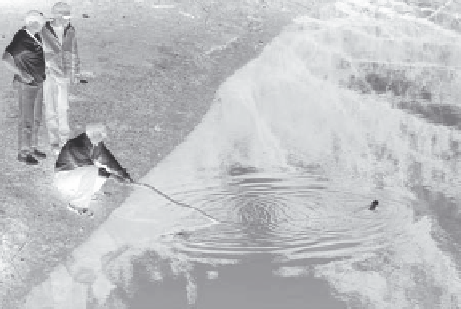Environmental Engineering Reference
In-Depth Information
Sample
container
FIGURE 4.28
Collecting a surface water sample using the dip method. (Photo by Daniel T. Rogers.)
here is the Dip Sampler, which only collects samples from the surface and is essentially a
sample container dipped into the water. Dip samplers are useful where access is limited
(Figure 4.28).
4.3.5 Air Sampling
Conducting subsurface investigations sometimes requires sampling air. Some contami-
nants migrate through subsurface soil and groundwater and may come into contact with
subsurface structures such as basements. When this event occurs, certain contaminants
have the potential to accumulate in these subsurface void spaces and contaminant the air.
Additionally, contaminants are released directly into the air and may become deposited
on the ground or water surfaces.
Under certain conditions, air sampling is justified when conducting a subsurface envi-
ronmental investigation for three purposes:
• Evaluating whether the source of soil or water contamination originated from air
deposition
• Protecting the health and safety of people during an investigation
• As part of conducting a risk assessment
Sampling for contaminants in air falls into two broad categories: contaminants in the vapor
or gas phase, and contaminants as particulates or sorbed to particulates (USEPA 1991). The
objectives of air sampling include the assessment of exposure for health reasons, and for
normal or ambient air quality. Exposure monitoring usually is performed with indoor air,
and ambient air monitoring is typically done with outdoor air.
4.3.5.1 Indoor Air Sampling
Before conducting any air sampling, a site inspection should be completed—especially if
the sampling will be conducted indoors. The inspection seeks to identify two conditions:


Search WWH ::

Custom Search